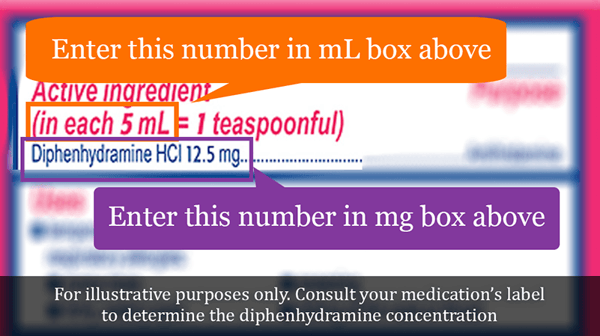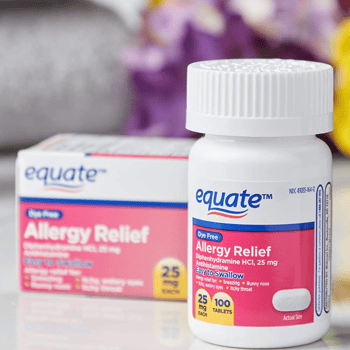Our mission is to help save dogs' and cats’ lives through our educational content. To support our efforts, this page may contain affiliate links. We earn a commission for qualifying purchases – at no cost to you.
How to Calculate Benadryl Doses for Your Dog or Cat
Before using a Benadryl® dosage chart or giving your dog or cat diphenhydramine, be sure to speak to a veterinarian. Let them know if your pet is on any other medications, including vitamins, supplements, and herbal formulations. It is important to be aware that some animals are hypersensitive to diphenhydramine and, especially if this is your first time administering this medication to your pet, monitor them closely following administration.
Pet Antihistamine Diphenhydramine Dosage Calculator
To calculate the Benadryl dose for dogs and cats, use the appropriate calculator – based on tablet or liquid medication. The dosage is calculated by the weight of your dog or cat. For instructions on how to use the calculator, see below.
Important Warning: Whether using the tablet or liquid form of Benadryl®, make sure it does not have any other ingredients. The only ingredient should be Diphenhydramine. See more warnings below.

PRO TIP: If your dog is difficult to give pills to, consider using a pill popper. Pill pockets are also a good option, but if your dog's face or throat is swollen, swallowing a pill pocket may be uncomfortable.
Using Benadryl® Pills or Tablets
To calculate your dog or cat's dosage in tablet form, enter their weight in the pill calculator further below. Give them a dose that falls within the minimum to maximum range, using whatever combination of whole and half pills it takes to get you to a dose within the dose range you've just calculated.
You do want to look at the medication box to find out how many milligrams (mg) of diphenhydramine are in each pill or tablet. Diphenhydramine pills are typically 25 mg each, but there are smaller 12.5 mg tablets and larger 50 mg tablets. You can adjust the tablet dosage in the calculator below to help you determine how many tablets to give within their dosage range.
Important Warning: Whether using the tablet or liquid form of Benadryl®, make sure it does not have any other ingredients. The only ingredient should be Diphenhydramine. See more warnings below.
Using Liquid Benadryl®
For liquid dosages, determine the concentration of diphenhydramine based on the medication's label (use the illustration above as a guide) and enter those values and your pet's weight into the Diphenhydramine Liquid Dosage Calculator.
Typical Uses of Diphenhydramine
Diphenhydramine has several uses that make it a good medication to keep in a pet’s first aid kit. The following is a list of the more common issues this antihistamine is used for:
- Bee, wasp, or hornet stings: Given at the time of the event or first sign of swelling. The dose is then repeated 4 to 6 hours later. Continued dosing is then every 8 hours for 2 to 3 days.
- Seasonal allergies: Dosing is every 8 to 12 hours but will vary with each pet.
- Skin itch: Relief varies from pet to pet. Dosing is every 8 to 24 hours.
- Light sedative for traveling: Diphenhydramine for travel anxiety is not effective for all pets. Typically given 1 to 2 hours prior to travel and can be repeated 8 hours later.
- Motion sickness: May help pets that get car sick. Given 2 hours prior to travel.
- Antiemetic: Can help alleviate nausea and vomiting for some pets. Dose every 8 hours.
WARNINGS WHEN GIVING YOUR PET Diphenhydramine (Benadryl)
- Make sure your medication ONLY has diphenhydramine as an active ingredient! Don't use any additional pain relievers, decongestants, or other drug types. So no Benadryl® Cold and Flu, Benadryl® Cold and Allergy, Tylenol® PM, Advil® PM, or any other combination medications containing diphenhydramine – just straight-up diphenhydramine.

- Double-check that there is no alcohol listed in the active ingredients of the diphenhydramine you're using for your pet.
- Make sure that the formulation of diphenhydramine you get for your dog does NOT contain xylitol, a common sweetener that is fine for people but highly toxic to dogs!
- If your pet is overweight or obese (be honest), calculate their dose based on what their ideal/target "lean" body weight should be.
- Benadryl® overdosing can cause pets to suffer agitation, sedation, vomiting, heart abnormalities, and other problems. So please be sure to double (and triple) check your doses before giving your pet this medication.
- Monitor your pet's swelling. If it is no better within an hour or gets worse at any point, you should take them to a veterinarian immediately for evaluation and further treatment. Similarly, if the swelling is present on their face or neck, or if they are having any difficulties breathing, they should be brought immediately to the vet.
When Not to Give Diphenhydramine to Your Pet
- If your pet has a known hypersensitivity or allergy to it or similar drugs
- Do not give to pediatric or neonatal pets (puppies and kittens)
- Use with caution if your pet has glaucoma, enlarged prostate, intestinal or bladder blockage, elevated thyroid hormones, heart disease, or high blood pressure
- Use with caution with senior, pregnant, lactating, or working pets
- Use with caution if your pet is receiving any of the following medications:
- CNS depressants: sedatives, pain meds, anesthetics
- Tricyclic antidepressants: Amitriptyline
- Anticholinergic drugs: atropine and glycopyrrolate
How to Use a Pill Gun to Give Your Cat Meds
Other Resources
- What to Do if Your Dog is Stung by a Wasp, Bee, or Hornet
- Options for Giving Your Pet a Pill
- How to Prevent and Treat Travel Anxiety in Dogs
- Pet InfoRx: Cat Ear Infection
- Pet InfoRx: Dog Ear Infection
- Pet InfoRx: Dog Demodicosis (Demodex) & Sarcoptic Mange (Scabies)
- Pet InfoRx: Dog Atopy & Food Allergies


